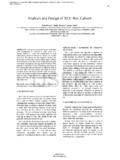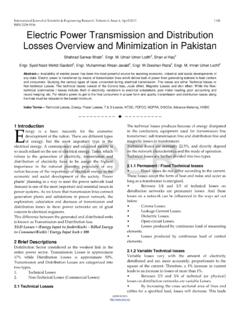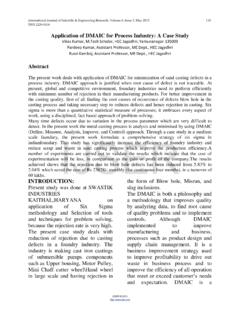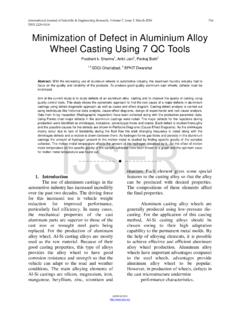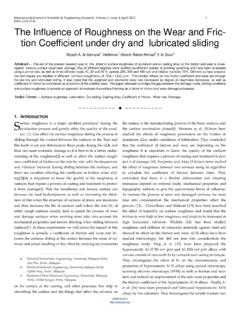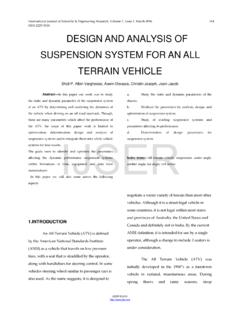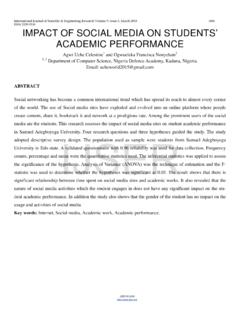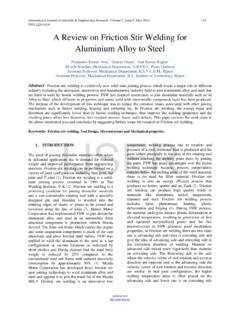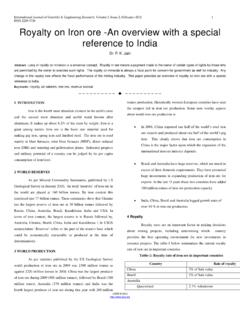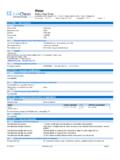Transcription of ASSESSMENT OF WATER QUALITY - IJSER
1 International Journal of Scientific & Engineering Research, Volume 5, Issue 12, December-2014. ISSN 2229-5518. 67. ASSESSMENT OF WATER QUALITY . Pooja. D. Somani1, Siddharath Ray2, Sanjay Singh3. Assistant Professor, Department of Civil Engineering, Saraswati College of Engineering, Kharghar, Navi Mumbai 1. Abstract: Potable WATER when passes through the deteriorates in distribution networks and during distribution system deteriorates in its microbial QUALITY . collection, storage so it becomes obligatory to Further the QUALITY of WATER deteriorates as it is stored in monitor WATER QUALITY at each stage. Apart from all sump tanks, overhead tanks and loft tanks. Since the tanks monitoring and surveillance, drinking WATER at tap are not regularly cleaned the QUALITY of WATER is affected as may not be potable. By the time WATER reaches the it reaches the end user. Due to irregular and improper cleaning of the tanks there is an accumulation of organic consumer, its QUALITY might be very different from matter in the tanks due to which the different what it was when it left the plant.
2 The management of microorganisms grow in WATER which leads to spread of distribution systems has become one of the most various diseases. In this study different sampling sites from difficult challenges to providing safe drinking WATER Navi Mumbai have been selected which are tested for free as pipes are buried and not subject to the direct residual chlorine and microbial contamination. Study control of WATER utilities. indicates that there is successive increase in the microbial Microbial contamination in distribution contamination as WATER passes from sump tank to overhead systems is a potential threat to public health. IJSER . tank. Maximum contamination is observed in case of WATER Pathways for the entry of contaminants into stored in loft tanks. Disinfection of tank can prove to be one of the measures to check the increase in MPN values in distribution systems include: organisms that survive WATER . the treatment process; contaminated ground- WATER that flows in from outside when pressure in a pipe Keywords: WATER QUALITY , MPN, Free Residual Chlorine drops; contamination during the installation or repair (FRC), Disinfection, Superchlorination of WATER mains; and backflow from non-potable systems connected to potable WATER system.
3 Whereas the chemical contamination can occur in the INTRODUCTION distribution system as a result of corrosion reactions, the accumulation of contaminated sediments, and the WATER plays an indispensable role in intrusion of chemical compounds into the pipes. sustenance of life and it is a key pillar of health Intentional contamination is also a potential threat. determinant, since 80% of diseases in developing The WATER through the treatment plant is countries are due to lack of good QUALITY WATER . Poor supplied to the consumer through Continuous WATER WATER QUALITY continues to pose a major threat to supply system or Intermittent WATER supply. The WATER human health. Diarrhoeal disease alone amounts to an passes through sump tanks and overhead tanks before estimated % of the total Disability-Adjusted Life reaching the consumer tap. In some cases due to Years (DALY) global burden of disease and is irregular or insufficient supply of WATER , additional responsible for the deaths of million people every storage of WATER is done in loft tanks in individual year [1].
4 Consequently, WATER borne diseases such as household. Cleaning of these tanks is often neglected. cholera and typhoid often have their outbreak Since the tanks are not regularly or properly cleaned, especially during dry season. High prevalence of there is an accumulation of organic matter in the diarrhea among children and infants can be due to the tanks due to which the different microorganisms grow use of unsafe WATER and unhygienic practice. Thus, in WATER which leads to spread of various diseases. many infectious diseases are transmitted by WATER The WATER QUALITY doesn't change much in other through fecal oral contamination. Diseases due to chemical and physical characteristics, but there may drinking of contaminated WATER leads to the death of be variance in the microbial QUALITY of WATER coming five million children annually and make 1/6 of the out of distribution system and finally that of world population sick [2]. consumer tap. The objective of the study is to assess WATER which is treated by different the bacterial QUALITY of WATER which actually reached Municipal bodies, meets all drinking WATER QUALITY the people through their taps.
5 This study also aims to standards at treatment plant and at the point where the analyze the degree of deterioration in the bacterial WATER enters the distribution system. WATER QUALITY IJSER 2014. International Journal of Scientific & Engineering Research, Volume 5, Issue 12, December-2014. ISSN 2229-5518. 68. QUALITY of WATER due to its storage in sump tank, given in Standard Method for the Examination of overhead tank and loft tank. Further the purpose of WATER and Wastewater. this study also extends to get the seasonal variation in Disinfection of loft tanks QUALITY of WATER which is passing through distribution system, sump tanks and overhead tanks before Superchlorination is done in the loft tanks at reaching the consumer. location 2 and location 3. Solution of bleaching powder is added to the loft tank such as to provide MATERIALS AND METHODS the chlorine dose of 8 mg/l. Samples from loft tank are analyzed after 24 hrs and then after every 10 days.
6 Sampling Locations Study was carried out by collecting samples RESULTS. from selected locations of Navi Mumbai. From each The test results for bacteriological QUALITY of location three samples are collected. One is from the WATER and for the residual chlorine for different direct supply (before entering the sump tank), second locations indicate that there is a steep increase in the from the tap connected to the overhead tank and the MPN value of the WATER coming from consumer tap third is from the tap connected to the loft tank. These samples are collected once a month from the period 16. 14. of August to March. MPN per 100 ml 12. 10. Questionnaire Survey 8. 6. Detail information regarding the supply 4. 2. hours of the WATER is collected. Information regarding IJSER . 0. the cleaning of tanks, cleaning schedules and cleaning method is collected. Sampling Month of Sampling Samples are collected from the selected sites Direct Supply Overhead Tank Loft Tank in plastic bottles.
7 500 ml of samples are collected from each location. Samples have been collected Figure 1 Temporal Variation of MPN for sample 1. from the taps allowing WATER to run waste for two to three minutes or to sufficient time permit the cleaning of service line. While collecting the sample from FRC mg/l direct supply care is taken that sample is collected before entering the sump tank. Care is taken to avoid splashing of WATER during filling of sampling WATER 0. from the tap. The sampling bottles were not filled up to the brim and two to three centimeter space was left for allowing shaking of bottle before analysis. Month of Sampling Chemical and Bacteriological Analysis Direct Supply Overhead Tank Loft Tank Min. Required All the samples collected are analyzed for Free available chlorine (FRC) by Orthotoluidine Figure 2 Temporal Variation of FRC for sample 1. Arsenite test (OTA) as described in the Manual on WATER Supply and treatment (CPHEEO). as compared to the direct supply tap.
8 Also there is Bacteriological characteristics of the WATER considerable reduction in the Free Residual Chlorine samples were determined using multiple tube as the WATER comes to consumer tap. fermentation method (most probable number) for For location 1 the results for bacteriological QUALITY enumeration of total coliform count. Lauryl Tryptose and free residual chlorine are given below. The values Broth (LTB) along with fermentation tubes (Durham of MPN range from per 100ml to 15 per 100 ml. tubes) was used. A serial dilution of the WATER sample Maximum value being in loft tank. In all set of to be tested was made and inoculated into LTB samples loft tanks have MPN value is more as growth media. Samples were then incubated at 35 2 compared to overhead tank. This indicates increase in C for 24 h. The analysis was conducted as procedure microbial contamination in overhead tank and loft tank. Moreover the microbial contamination increases IJSER 2014.
9 International Journal of Scientific & Engineering Research, Volume 5, Issue 12, December-2014. ISSN 2229-5518. 69. successively from august to march in the overhead Maximum value of MPN is observed in tank and loft tank. loft tank in the month of January. For location 2 the MPN value ranges from 0. to 14 per 100 ml. The maximum value of free residual chlorine in direct supply WATER is found to be mg/l Month of Sampling FRC mg/l in the month of august and for this period the MPN 1. value is zero. Disinfection of loft tank is done by doing superchlorination by providing a chlorine dose 0. of 8 mg/l in loft tank. It could be observed that the MPN value in the loft tank after addition of chlorine has come down to zero. 16 Direct Supply Overhead Tank MPN per 100 ml 14. 12 Loft Tank Min. Required 10. 8 Figure 6 Temporal Variation of FRC for sample 3. 6. 4. 2. 0 Disinfection of loft tank is done in the month of February by doing superchlorination by providing a chlorine dose of 8 mg/l in the loft tank.
10 It could be observed that the MPN value in the loft tank after addition of chlorine has IJSER . Period of Sampling Direct Supply Overhead Tank Supply Tank reduced to zero. But after a period of approximately 2 months microbial Figure 3 Temporal Variation of MPN for sample 2. contamination started to increase again. In case 3 of direct supply WATER in none of the WATER FRC mg/l Month of Sampling sample the free residual chlorine is more than 2. mg/l which the minimum amount of chlorine 1 required as per CPHEEO standards. 0. DISCUSSIONS AND CONCLUSIONS. The study of MPN values at different locations for different period of time indicates Direct Supply Overhead Tank Loft Tank Min. Required that the microbial contamination increases as the WATER moves from sump tank and overhead tank. Figure 4 Temporal Variation of MPN for sample 2 And further there is significant rise in MPN. values in the WATER from loft tank. For location 3 the MPN value ranges from to 24 per 100ml.
